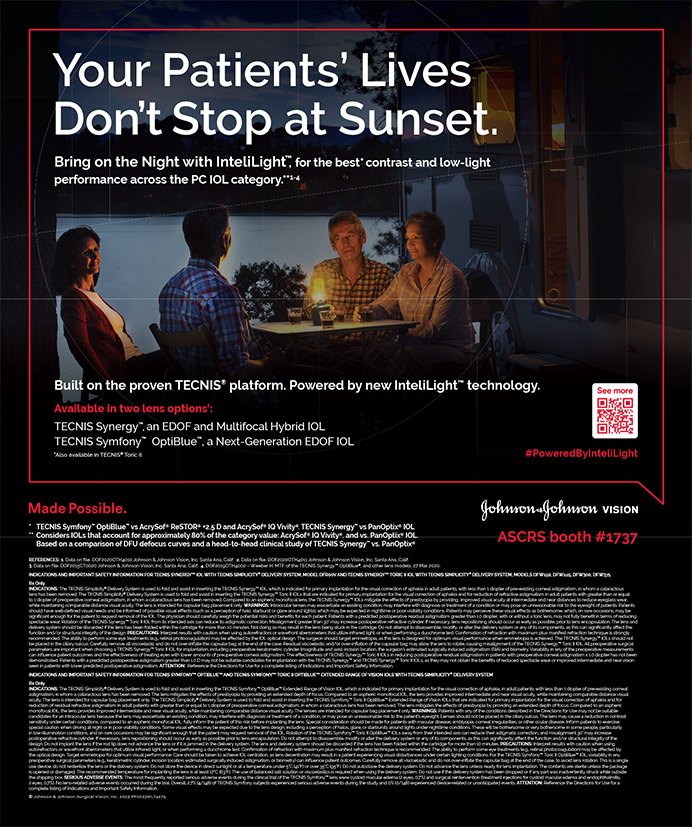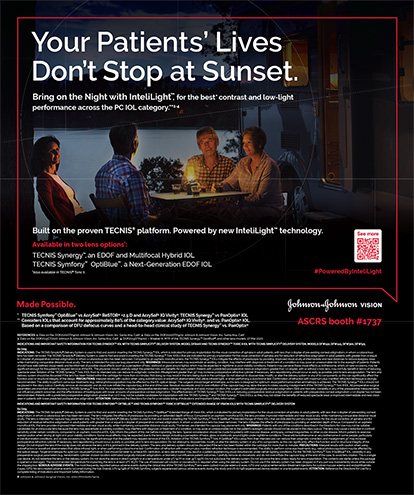The presbyopic population is large and growing: it is expected to number 2.1 billion worldwide by 2020.1 This group desires good uncorrected vision at all distances, without unnecessary risks or visual compromises.
Current surgical interventions for presbyopia include corneal refractive surgery with a monovision or blended vision target and refractive lens exchange. Corneal refractive surgery may reduce distance acuity, stereopsis, contrast sensitivity, or quality of vision, and lens exchange prior to the development of significant cataracts is considered by many surgeons to be too invasive. In contrast, corneal inlays are additive, do not remove tissue, and preserve future options for presbyopic correction. Some inlays can be used in combination with other refractive and cataract procedures, and all are removable.
There are currently three different types of inlays in various stages of development in the United States.
REFRACTIVE OPTIC INLAYS
The Flexivue Microlens (Presbia) and the Icolens (Neoptics AG) both provide distance vision through a plano central zone that is surrounded by a ring of varying add power for near vision, similar to multifocal contact or intraocular lenses. The Flexivue is a transparent hydrogel implant with a 3-mm diameter that contains an ultraviolet light blocker. The inlay has a 0.15-mm opening in the center to facilitate the flow of fluid and nutrients. The opening is surrounded by a plano central zone and a refractive peripheral zone with add power from +1.25 to +3.50 D.
Data presented at scientific meetings have shown positive results in small cohorts, but the published literature is limited on the Flexivue. A prospective study of 47 emmetropes with the inlay implanted in a femtosecond laser-created corneal pocket in the nondominant eye found that uncorrected near visual acuity (UCNVA) was 20/32 or better in 75% of implanted eyes at 12 months.2 Although mean binocular uncorrected distance visual acuity (UCDVA) was not affected, there was a statistically significant decrease in mesopic and photopic contrast sensitivity at a number of spatial frequencies and an increase in higher-order aberrations in the implanted eyes. Overall, patients' satisfaction and level of spectacle independence were high.
The Icolens is based on a design similar to that of the Flexivue lens. There have been promising early reports at professional meetings from clinical trials in Europe.3 As yet, nothing about the Icolens has been published in the peer-reviewed literature, however, and no clinical trials have begun in the United States.
CORNEAL RESHAPING INLAYS
The Raindrop Near Vision Inlay (ReVision Optics, Inc.) is a clear hydrogel lens with a very small diameter. Its hyperprolate shape is intended to reshape the anterior curvature of the cornea to enhance near and intermediate vision via a multifocal effect. Data from a clinical trial of 18 hyperopic eyes implanted with the 2-mm inlay reflected an average UCNVA improvement of more than 5 lines by 1 month after surgery, and 78% of the implanted eyes achieved 20/20 UCNVA or better.4 Uncorrected intermediate visual acuity improved by an average of 4 lines, and mean UCDVA was 20/25. Another study combining the inlay with LASIK showed similarly positive results.5 This inlay is available in the European Union and is currently in a phase 3 clinical trial in the United States.
SMALL-APERTURE INLAYS
The Kamra Inlay (AcuFocus, Inc.) is a 5-μm–thick microperforated, opaque disc that utilizes the principle of a small aperture to increase the eye's depth of focus. The inlay is 3.8 mm in total diameter and has a central hole, or aperture, measuring 1.6 mm. Globally, nearly 20,000 of these inlays have been implanted to date. The device has CE Mark approval, and the company has submitted a complete premarket approval to the FDA (Figures 1 and 2).
Of all the inlays, the Kamra has the most published research available for review. Overall, the literature demonstrates that implantation of a small-aperture inlay results in a sustained improvement in near and intermediate vision while maintaining good distance vision. Mean UCNVA in multiple studies was J1, with 96% to 97% of treated eyes seeing J3 or better and no significant loss of binocular UCDVA.6,7 A recent large study of 180 eyes implanted with the inlay and simultaneous LASIK surgery showed that the mean UCNVA improved by 7 lines in hyperopic eyes, 6 lines in emmetropic eyes, and 2 lines in myopic eyes 6 months after treatment. Intermediate acuity also improved, with 91% of eyes seeing at least 20/32 or better. All patients had a binocular UCDVA of 20/20 or better. Patients' overall level of satisfaction was high, and their dependence on reading glasses decreased.8
CONCLUSION
The presbyopic population is the fastest-growing demographic globally, and its members are extremely interested in spectacle-free vision. For refractive surgeons, having a reliable method for addressing this growing demand is important. Currently, there are no other effective options for presbyopes without the risks of intraocular surgery or visual compromises. Based on the clinical experience to date, the minimally invasive nature of corneal inlays, and their removability, I believe this modality will play an ever-increasing role in our practices for the correction of presbyopia.
None of the inlays mentioned herein is FDA approved.
Richard L. Lindstrom, MD, is the founder of and an attending surgeon at Minnesota Eye Consultants, PA, in Bloomington. He is a consultant to and has equity in AcuFocus, Inc. and has equity in ReVision Optics. Dr. Lindstrom may be reached at (612) 813-3600; rllindstrom@mneye.com.
- The 2012 Statistical Abstract. U.S. Census Bureau. Accessed March 19, 2013. http://www.census.gov/compendia/ statab/cats/population.html
- Limnopoulou AN, Bouzoukis DI, Kymionis GD, et al. Visual outcomes and safety of a refractive corneal inlay for presbyopia using femtosecond laser. J Refract Surg. 2013;29(1):12-18.
- O'Keefe M, Baily C. Novel corneal inlay for the treatment of presbyopia. Paper presented at: ESCRS 2012; September 8-12, 2012; Milan, Italy.
- Porter T, Lang A, Holliday K, et al. Clinical performance of a hydrogel corneal inlay in hyperopic presbyopes. Invest Ophthalmol Vis Sci. 2012;53:e-abstract 4056.
- Lang AJ, Porter T, Holliday K, et al. Concurrent use of the ReVision Optics intracorneal inlay with LASIK to improve visual acuity at all distances in hyperopic presbyopes. Invest Ophthalmol Vis Sci. 2011;52:E-abstract 5765.
- Yilmaz OF, Alagoz N, Pekel G, et al. Intracorneal inlay to correct presbyopia: long-term results. J Cataract Refract Surg. 2011;37:1275-1281.
- Seyeddain O, Hohensinn M, Riha W, et al. Small-aperture corneal inlay for the correction of presbyopia: 3-year followup. J Cataract Refract Surg. 2012;38(1):35-45.
- Tomita M, Kanamori T, Waring GO 4th, et al. Simultaneous corneal inlay implantation and laser in situ keratomileusis for presbyopia in patients with hyperopia, myopia, or emmetropia: six-month results. J Cataract Refract Surg. 2012;38(3):495-506.


